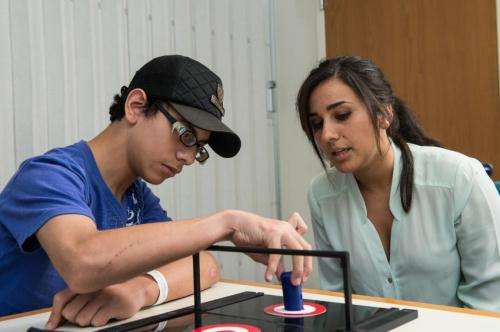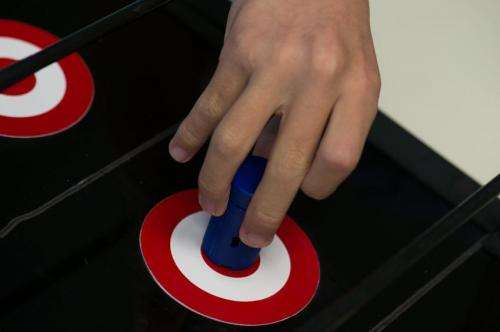Rice University student Sonia Garcia works with Brandon Sierra, a patient at Shriners Hospital for Children, to test the DeXcellence device. Garcia is part of a team of senior engineering students that built the device to measure the dexterity of cerebral palsy patients with a Bluetooth-enabled peg that can be tracked by a computer. Credit: Jeff Fitlow/Rice University
(Medical Xpress)—It looks like a game board and many of its users will find it fun, but there's serious intent behind a device by Rice University students to test the abilities of cerebral palsy patients.
At the heart of the DeXcellence platform is a small peg comfortable enough for a 3-year-old to hold. But packed inside are enough electronics to tell a nearby computer, tablet or other Bluetooth-enabled device of how the cylinder is moving in space.
In tandem with a board that directs the patient's movements, the cylinder sends a steady stream of data to the computer. That data is analyzed by the Rice team's software to give a therapist a clear picture of a patient's progress in physical therapy.
The DeXcellence device is the work of five Rice seniors who designed it at the Oshman Engineering Design Kitchen as their capstone project in collaboration with Shriners Hospital for Children, Houston, and Rice advisers Gary Woods, a professor in the practice of computer technology in the Department of Electrical and Computer Engineering, and Eric Richardson, a lecturer in bioengineering.
It would complement the device that inspired it, a low-tech pegboard for evaluation known as a Functional Dexterity Test (FTD), in the clinic of Shriners' doctor Gloria Gogola, who suggested the students look into a way to quantify movement.
"We got to go there and watch patients use the peg board, and we could see them cheat," said bioengineering major Sonia Garcia, a member of the team with Shaurya Agarwal (mechanical engineering), Allison Garza (mechanical engineering), Vivaswath Kumar (electrical and computer engineering) and Andrew Schober (bioengineering and computational and applied math). "Instead of turning the peg in the air, they would drop it and then move it into the hole."
The DeXcellence device doesn't let that happen. Their portable board has two sides. One has targets and pop-up hurdles. The patient must pick the cylinder up from the center of one target and turn it 180 degrees while moving over the hurdle to the center of the next target. On the flip side is a set of paths the patient tracks with the peg.
All the while, the electronics are silently sending data on where the cylinder is in space as well as its speed and orientation.
"There is a big gap in technology for the evaluation of movement patterns in (patients with) cerebral palsy," Gogola said. "At one end, we have clinical exams that are all visual. We even videotape exams so we can watch them again to catch more subtle things."
At the other end is Shriners' high-tech motion analysis lab, which involves putting markers on patients and uses motion-sensor cameras and computers to gather information as they move, she said.
"This project aims for the middle," she said of the Rice team's work. "We want to bring more tech to the clinic. The peg the patient moves through the test provides motion-path data therapists can't quantify by eye. It's like a motion analysis lab in a peg!"
The DeXcellence device invented by senior engineering students at Rice University tracks the dexterity of cerebral palsy patients through their ability to move a Bluetooth-enabled cylinder through a series of tasks. Credit: Jeff Fitlow/Rice University
The students worked hard to present a polished project. "We have the motion-capture technology with the peg, we have the exam itself, we built the software in the computer and we have the charger for the peg," Agarwal said. "That's what we set out to do. We wanted to give them the entire solution; not one part of it, but everything they need to conduct an exam."
Their success was recognized by all who watched the DeXcellence team demonstrate it at Rice's annual George R. Brown Engineering Design Showcase and Poster Competition, at which the team won the grand prize of $5,000 in April. The team also placed second in the International Student Design Showcase at the University of Minnesota's Design of Medical Devices conference in April.
Those were highlights of their final year at Rice, to be sure, but they were just as thrilled to see their device in use at Shriners. A week before graduation, the students gathered at Shriners to observe as Brandon Sierra, 15, put the device through its paces. Sierra underwent surgery on his right arm in April to help him regain motion in the arm that had been hindered by hemiplegic cerebral palsy.
"I think the possibilities for this are enormous," said occupational therapist Dorit Aaron, former president of the American Society of Hand Therapists and a Shriners volunteer. "The device is different from the original FTD in the sense that it requires both gross motor as well as fine motor movements to accomplish the task. They have to manipulate the peg and they have to move it in space. That gives us information about the shoulder and elbow motion as well as the digits, and we can track it in the computer."
"One of the realistic problems in the clinic is that we don't have time. We need outcomes that can be substantiated, that are valid and reliable for the people we're treating. This has the potential to be absolutely breakthrough with the cerebral palsy population whose coordinated motions are so difficult to quantify," she said.
Gogola perceives a future for the Rice invention beyond cerebral palsy therapy. "This device could be used in any situation where dexterity, or the fine motor movements of the hand, need to be tested," she said. "For example, it could be used to evaluate patients recovering from stroke, spinal cord injuries, trauma—any situation where the ability to use their hands is affected."
More information: DeXcellence team page: oedk.rice.edu/Content/Members/ … 96&memberId=10927882
Provided by Rice University

























